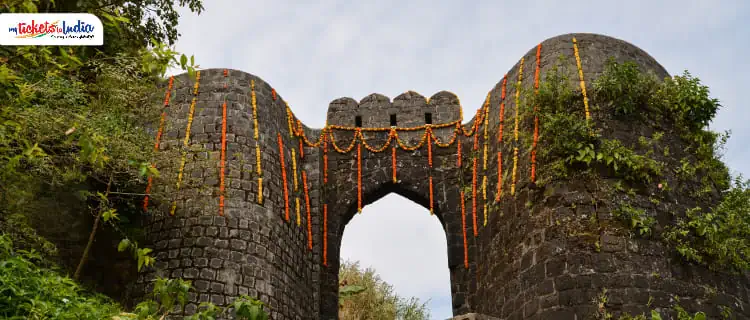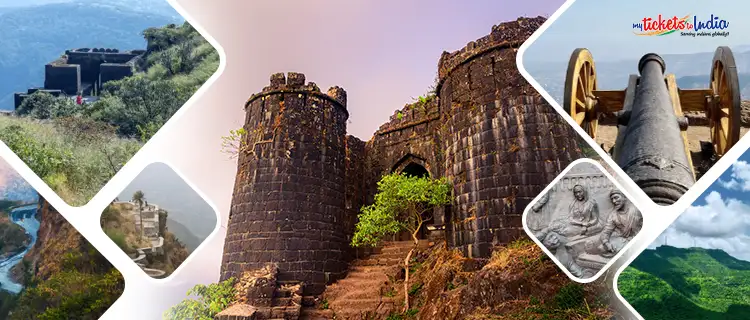Sinhagad Fort: A Historical Place and Trekking Adventure

Posted on Tuesday, November 19th, 2024
by Neha Sharma
High on hilltop in Maharashtra’s Western Ghats, Sinhagad Fort, or the “Fort of the Lion,” is a historical treasure with panoramic views and stories of bravery. Known for the legendary battle led by Maratha warrior Tanaji Malusare, this fort holds a special place in Maharashtra’s history. Its ancient gates, winding paths, and rugged terrain make it a fascinating spot for history enthusiasts, trekkers, and nature lovers alike. A visit to Sinhagad Fort is a journey through time, offering a unique blend of natural beauty and heroic tales from the past.
| Information | Details |
| Name | Panhala Fort |
| Location | Panhala, near Mumbai |
| Type | Hill Fort |
| Area | Not specified |
| Depth | Not applicable |
| Purpose | Defense, historical site |
| Construction Year | Originally built in the 12th century, expanded in subsequent centuries |
| Features | Impressive fortifications, bastions, water tanks, temples |
| Historical Significance | Witnessed several battles and historical events, associated with Maratha history |
| Surroundings | Western Ghats, Sahyadri mountain range, lush greenery |
History and Origins Of Sinhagad Fort
Sinhagad Fort, originally known as Kondhana Fort, has a history that spans over 2,000 years, dating back to the Yadava Dynasty in the 12th century. Perched atop the Sahyadri Mountains near Pune, it gained strategic importance under Chhatrapati Shivaji Maharaj, who recognized its value as a natural stronghold. The fort became legendary in 1670 when Shivaji’s loyal commander, Tanaji Malusare, led a daring mission to reclaim it from the Mughals. Tanaji’s brave sacrifice in the battle deeply moved Shivaji, who named it “Sinhagad,” meaning “Fort of the Lion,” to honor his fallen warrior.
Over time, the fort changed hands between the Marathas, Mughals, and British, each adding to its layered history. Today, Sinhagad stands as a symbol of Maratha valor and resilience, with its ancient walls, gates, & temples inviting visitors to relive its storied past.
Architecture of Sinhagad Fort
Sinhagad Fort’s architecture combines natural defenses with strategic structures, making use of its high-altitude location and rugged cliffs. Situated 1,312 meters above sea level, it has two main gates: Pune Darwaza and Kalyan Darwaza, both fortified with thick stone walls and arches that control entry points. Within the fort are ancient water cisterns, storage areas, and hidden escape routes that allowed defenders to withstand long sieges. Key landmarks include Tanaji Kada, named after the Maratha warrior Tanaji Malusare, and temples dedicated to Shiva and Hanuman, reflecting both the fort’s military and spiritual significance. The fort’s design showcases Maratha ingenuity, harmonizing with the surrounding landscape to enhance its defense.
Sinhagad Fort Photos

How to Reach Sinhagad Fort
By Bus – From Pune, you can take a state-run or private bus to the base of Sinhagad Fort. Buses run from Swargate Bus Station to the village of Donje, which is near the fort. From Donje, shared jeeps or rickshaws are available to take you closer to the starting point of the trek up to the fort.
By Flight – The nearest airport to Sinhagad Fort is Pune International Airport, about 35 kilometers away. From the airport, you can hire a taxi or use app-based cab services to reach the fort. Alternatively, you can take a bus or train to Pune city center, then proceed by bus or taxi to the fort.
By Train – Pune Junction is the nearest railway station, located around 30 kilometers from Sinhagad Fort. From Pune Junction, you can take a bus from Swargate Bus Station or hire a taxi directly to the fort.
Best Time To Visit Sinhagad Fort
The best time to visit Sinhagad Fort is during the cooler months, from October to March. During this time, the weather is pleasant, making it ideal for trekking & exploring the fort. The temperatures are comfortable, & the surrounding hills are green, especially after the monsoon season. If you love the monsoon atmosphere, visiting in June to September can also be enjoyable, as the fort is surrounded by mist & vibrant greenery, though the trek can be challenging due to the rain. Avoid visiting in the peak summer months (April to June) as it can get quite hot and exhausting.
Interesting facts about Sinhagad Fort
- Strategic Location: The fort’s position atop the Sahyadri mountains made it almost impregnable. Its steep cliffs on all sides acted as natural defenses, making it a tough target for invaders.
- Legend of the Name: Originally known as Kondhana, the fort was renamed Sinhagad (meaning “Lion’s Fort”) after the heroic battle of Tanaji. The name “Sinhagad” symbolizes courage and valor, reflecting Tanaji’s sacrifice.
- Water Storage Systems: Sinhagad Fort has impressive water storage systems, with several water tanks carved into the rock, which helped the defenders survive during long sieges. These water tanks still hold water even after centuries.
- Hidden Escape Routes: The fort has a series of secret escape routes and tunnels that were used by the soldiers to sneak in or out during emergencies, adding a layer of mystery to its architecture.
- Rajaram Samadhi: Within the fort complex, there is a memorial dedicated to Rajaram Maharaj, the son of Shivaji, who is believed to have stayed at Sinhagad Fort during his reign. The Rajaram Samadhi is an important site for visitors.
- Temples Inside the Fort: The fort houses several ancient temples, including those dedicated to Lord Shiva and Lord Hanuman, showing the spiritual importance the fort held for its inhabitants.
- Battle-Scarred Walls: Many of the fort’s structures, including its gates and walls, still bear the scars from the numerous battles it witnessed over centuries, adding to its historical significance.
Entry fee and timings of Sinhagad Fort
Entry Fee:
- For Indian Visitors: ₹20
- For Foreign Visitors: ₹100
Timings:
- Open: 6:00 AM to 6:00 PM (Daily)
- Best Time to Visit: Early morning or late afternoon to avoid the heat, especially during summer months.
Nearby Attractions in the Sinhagad Fort
| Nearby Attraction | Distance from Sinhagad Fort |
| Khadakwasla Dam | Approximately 10 kilometers |
| Panshet Dam | Approximately 15 kilometers |
| Raigad Fort | Approximately 20 kilometers |
| Shivneri Fort | Approximately 25 kilometers |
| Rajgad Fort | Approximately 30 kilometers |
| Torna Fort | Approximately 35 kilometers |
| Purandar Fort | Approximately 40 kilometers |
| Shaniwar Wada | Approximately 45 kilometers |
| Lal Mahal | Approximately 50 kilometers |
| Dagdusheth Halwai Ganpati | Approximately 55 kilometers |
Visitor Guidelines and Pro Tips
- Wear Comfortable Footwear: The trek up to the fort can be steep and uneven, so wear sturdy shoes for easy climbing.
- Respect Local Culture: Dress modestly, especially when visiting temples inside the fort, to show respect to local customs.
- Stay Safe: Avoid venturing too close to the fort’s edges, as the cliffs can be dangerous, especially in misty or rainy weather.
- Visit Early Morning: The fort opens early, and visiting in the morning will allow you to enjoy cooler weather and avoid crowds.
- Explore the Trek: If you’re up for adventure, trek from the base to the fort for a rewarding experience and scenic views along the way.
- Carry Snacks: There are small eateries near the base, but it’s a good idea to pack light snacks if you plan to stay longer.
- Best Time for Photography: Sunset offers fantastic views, with the fort and the surrounding hills bathed in golden light – perfect for photographs.
- Take a Guide: Hiring a local guide can enhance your experience, offering interesting facts and history about the fort’s strategic importance and past battles.
Other Activities To Do in Mumbai
Mumbai is home to many beautiful beaches beyond the popular Juhu Beach. Marine Drive Chowpatty is famous for street food & sunsets, while Versova Beach offers peaceful walks and ocean views. Aksa Beach is perfect for those seeking calm, and Gorai Beach is great for a day trip. These beaches are top spots for Tourism in Mumbai, offering a mix of tranquility and local flavor.
Other Popular Attractions in India
India is home to many incredible attractions that highlight its rich culture & history. From the iconic Taj Mahal in Agra to the amazing Amer Fort in Jaipur, & the spiritual aura of Varanasi, each destination offers a unique experience. The crowded markets of Delhi, serene backwaters of Kerala, & vibrant palaces of Rajasthan are all must-visit spots. These landmarks play a key role in Tourism in India, attracting millions of travelers every year to explore the country’s diverse beauty and heritage.
Frequently Asked Questions
Q: What are the top tourist attractions in India?
A:
Some of the top attractions include the Taj Mahal in Agra, Amer Fort in Jaipur, Varanasi for its spiritual experience, Kerala backwaters, Delhi markets, and Rajasthan palaces.
Q: Which city in India is best for history and culture?
A:
Cities like Agra, Jaipur, Delhi, and Varanasi are known for their rich history, culture, and iconic landmarks.
Q: What are the must-visit places in Rajasthan?
A:
Rajasthan is famous for its beautiful palaces and forts, including Amer Fort, City Palace in Jaipur, and the magnificent Umaid Bhawan Palace in Jodhpur.
Q: When is the best time to visit India for tourism?
A:
The best time to visit India is from October to March when the weather is cooler and ideal for sightseeing.
Q: How can I explore the backwaters of Kerala?
A:
You can explore Kerala famous backwaters by renting a houseboat, which offers a peaceful and scenic journey through the waterways.
Q: Why is the Taj Mahal so famous?
A:
The Taj Mahal in Agra is a symbol of love and one of the Seven Wonders of the World, renowned for its stunning architecture and beautiful surroundings.
Contact MyTicketsToIndia today and let our travel experts assist you in finding the best flight deals. We specialize in offering great discounts on flights from the USA to India. Don’t miss out on these fantastic offers—book your tickets now and embark on your amazing journey!